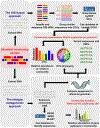Intestinal Microbiota in Cardiovascular Health and Disease: JACC State-of-the-Art Review
- PMID: 31023434
- PMCID: PMC6518422
- DOI: 10.1016/j.jacc.2019.03.024
Intestinal Microbiota in Cardiovascular Health and Disease: JACC State-of-the-Art Review
Abstract
Despite major strides in reducing cardiovascular disease (CVD) burden with modification of classic CVD risk factors, significant residual risks remain. Recent discoveries that linked intestinal microbiota and CVD have broadened our understanding of how dietary nutrients may affect cardiovascular health and disease. Although next-generation sequencing techniques can identify gut microbial community participants and provide insights into microbial composition shifts in response to physiological responses and dietary exposures, provisions of prebiotics or probiotics have yet to show therapeutic benefit for CVD. Our evolving understanding of intestinal microbiota-derived physiological modulators (e.g., short-chain fatty acids) and pathogenic mediators (e.g., trimethylamine N-oxide) of host disease susceptibility have created novel potential therapeutic opportunities for improved cardiovascular health. This review discusses the roles of human intestinal microbiota in normal physiology, their associations with CVD susceptibilities, and the potential of modulating intestinal microbiota composition and metabolism as a novel therapeutic target for CVD.
Keywords: dysbiosis; intestinal microbiota; secondary bile acids; short-chain fatty acid; trimethylamine N-oxide.
Copyright © 2019 American College of Cardiology Foundation. Published by Elsevier Inc. All rights reserved.
Figures




References
-
- Benjamin EJ, Virani SS, Callaway CW et al. Heart Disease and Stroke Statistics-2018 Update: A Report From the American Heart Association. Circulation 2018;137:e67–e492. - PubMed
-
- Estruch R, Ros E, Salas-Salvado J et al. Primary prevention of cardiovascular disease with a Mediterranean diet. The New England journal of medicine 2013;368:1279–90. - PubMed
-
- Cerf-Bensussan N, Gaboriau-Routhiau V. The immune system and the gut microbiota: friends or foes? Nat Rev Immunol 2010;10:735–44. - PubMed
Publication types
MeSH terms
Substances
Grants and funding
LinkOut - more resources
Full Text Sources

